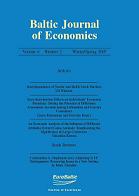An Economic Analysis of the Influence of Different Attitudes Toward Game Animals: Emphasizing the Significance of Large Carnivores
An Economic Analysis of the Influence of Different Attitudes Toward Game Animals: Emphasizing the Significance of Large Carnivores
Author(s): Yukichika KawataSubject(s): Economy
Published by: BICEPS/SSE Riga
Keywords: Predator–prey model; pest predator; willingness to pay; non-use value; attitude toward game animals
Summary/Abstract: This paper investigates the influence of a change in attitude toward the sustainable resource use of wild animals that exist under a prey–predator relationship. We build a theoretical model in which use value (price value) and non-use value (for example, existence value) are incorporated; we then conduct a numerical simulation to examine several cases with varying values. The primary results are as follows. Firstly, we reaffirm that it is important for people to value prey as well as predators in order to maintain a viable population. Secondly, as the willingness to pay for the prey increases relative to the price of the prey, the amount of the resource will be prioritized over the amount of the harvest. Thirdly, the minimum/maximum price may be required for resource conservation and conservation rather than protection is required even if the willingness to pay for the prey increases. Finally, the existence of the predator is desirable in that it improves the optimal resource level of the prey.
Journal: Baltic Journal of Economics
- Issue Year: 6/2006
- Issue No: 2
- Page Range: 58-78
- Page Count: 22
- Language: English

